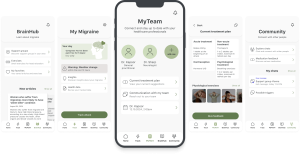Design of a Patient-Centered Mobile Application To Empower People Who Experience Migraine in Their Health Competency Through an Interprofessional Approach
Aim and Research Question(s)
The aim of this thesis is to empower people who have experienced symptoms of migraine by interprofessional care. The following research questions are intended to ensure that the focus is on patients and their needs when designing a mobile application. RQ1: What are current options for empowering people who experience migraine symptoms in their health competency? RQ2: What are current experiences and challenges of people who experience migraine in terms of interprofessional care, and what do they need to be more empowered? RQ3: How can a mobile application be designed to meet the identified needs?
Background
Headache disorders are one of the major public health issues globally and was ranked as the second-leading cause of disability [1]. People who experience migraine are facing many challenges, e.g. the need to deal with the unpredictability and the variability in migraine characteristics among patients, which makes it difficult to identify and manage symptoms and triggers. Migraine therapy requires collaborative care involving multiple healthcare professionals addressing these challenges through personalized approaches [2].
Methods
A narrative literature review and research on existing applications served as a basis for the general understanding of migraine, interprofessional care, patient empowerment and patient education. Qualitative user research was conducted through two moderated group discussions with a total of eight participants (aged between 30 and 58). The group discussions were transcribed, coded and analyzed using qualitative content analysis according to Kuckartz and Rädiker [3]. Based on these findings the design of a patient-centered mobile application (clickable prototype) was made.
Results and Discussion
The market analysis reveals that current mobile applications provide detailed trackers, but lack access to multiple healthcare professionals. Affected persons find the current healthcare fragmented and feel the need for a more integrated approach. They seek a solution that goes beyond just pain medications, favoring a central hub that offers a holistic treatment and supports interdisciplinary collaboration. The ideal mobile application should integrate comprehensive health data, deliver personalized alerts, and enable effective communication among various healthcare professionals.
Conclusion
References
[1] T. J. Steiner et al., “Migraine and disability: findings from GBD2019,” J. Headache Pain, vol. 21, p. 137, 2020. [2] D. A. Marcus and D. M. Ready, “The Migraine Team,” in Discussing Migraine, Springer, 2017, pp. 61–69. [3] U. Kuckartz and S. Rädiker, Qualitative Inhaltsanalyse, 5th ed., Beltz Juventa, 2022. [4] K. Weishäupl, “eHealth-Strategie Österreich,” Bundesmin. f. Soziales, Jun. 2024. Accessed: Jul. 22, 2024. [Online]. Available: https://www.sozialministerium.at.
